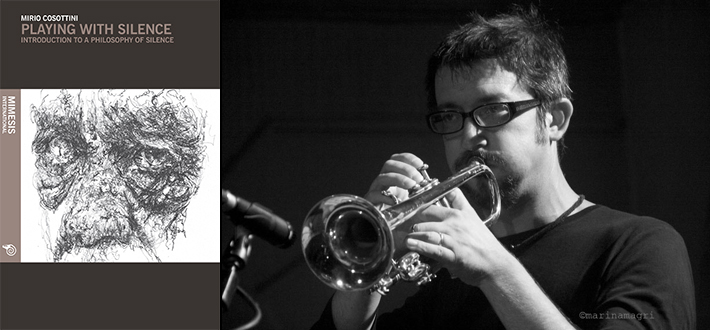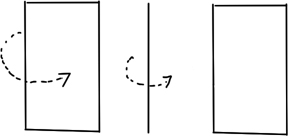MIRIO COSOTTINI

Cosottini photo by Marina Magri
by Daniel Barbiero
(April 2017)
Silence is an essential part of music. This is true whether we consider it in its syntactic function -- that is, in its role as an element constituting and making plain the order of musical events -- or in its semantic function, which is to say, its role as an element contributing to the musical meaning of a piece. With his short book Playing with Silence: Introduction to a Philosophy of Silence, Italian composer/improviser Mirio Cosottini considers silence not only as an aspect of music, but as an important element at work in our interactions with environment and with others.
Cosottini's multidimensional perspective on silence arises naturally from his background in academics and in musical performance. A graduate of the Academy of Music in Florence who subsequently pursued a doctorate in the philosophy of music from the University of Florence, Cosottini has composed music for dance, theater and film, and is an improvising trumpeter who co-founded the Gruppo di Ricerca Improvvisazione Musicale. His practical and philosophical sides are both well represented throughout the book.
Cosottini's initial focus is on ways of thinking about silence in the context of performance practice. But he is just as interested in the implications of the many meanings, functions and possible uses that silence has in our lives in general. His book is thus a kind of user's manual for silence in its different qualities and applications. It consists of a set of questions, suggestions and exercises formulated to stimulate the reader to think about the nature of silence -- what it is, or can be, or can mean--and to incorporate the resulting insights into his or her artistic practice as well as everyday activities. Cosottini structured the book to contain one thought or exercise per page, and in order to allow the reader adequate space for reflection, recommends that he or she read one page per day. What emerges is a philosophy of action informed by the role silence can play in orienting us in the world and in relation to each other.
It may be that someone involved in creating and thinking about music is best positioned to ask more penetrating questions about silence. Music provides a firm and often revealing point of reference for framing questions about silence. It's often through music that we confront silence as something to be confronted. In those gaps between notes, harmonies and other musical sounds, we become aware that the apparent nothingness that is the absence of sound is in fact something -- a structure of experience that goes beyond music and permeates our lives, whether as a way of being aware of time or as a way of being receptive to the environment and to other people. The phenomenology of silence -- the way a thing or situation appears to us as being silent or containing silence -- is correspondingly complex. It may even be that for us silence just is a matter of phenomenology -- an appearance emerging from the way attention is directed, for example, to contrasts within the audio field, as when we hear a silence in the aftermath of a musical crescendo, even while ambient sounds are present. Silence plays different roles and carries different meanings under different conditions, and many of Cosottini's exercises are pointed towards letting the reader imagine or enact some of these different conditions in order to understand silence's effect within them.
During late winter and early spring, Mirio and I conducted a transatlantic email conversation about silence and its implications for music and beyond. In a few instances, I've included Mirio's Italian terms in hard brackets after the English, where I thought it might help amplify his meaning. This is part one of a two part series.
PSF: Silence I think is a fundamental aspect of music. To use an agricultural metaphor, it's the ground on which music is cultivated. There's a temptation to think of it as an empty ground, but if we approach it more closely, it turns out to be something rather full.
Mirio Cosottini: I fully agree with you, if we take the agricultural metaphor. We realize the imaginative richness of silence, if we reflect on its phenomenological value. Mostly, silence was regarded as a pause between sounds (showing the "grammar" function within the musical discourse). Yet it may also turn out as a different mode of manifestation of the sound, the sound in a different form. To make a geometric analogy: a square is different from a rhombus, but starting from the operations of projective geometry, the square and the rhombus are essentially the same figure, a figure that has undergone a unique transformation, but that did not compromise the fundamental invariants. From the point of view of perception, the same thing happens. Sound and silence manifest their essence when considered according to certain structural invariance. The richness of silence is another way of seeing the richness of transformations that we can operate on sound.
PSF: I think that's true. Consider how silence in the context of music takes on a musical color. At what point does silence uncolored by the memory of the music that has just taken place take over from the silence that still is colored by the music? At what point, and how, do we draw the boundary between silence as an upsurge in music and the silence that surrounds us in daily life?
MC: In my opinion your question focuses on the ways in which silence is manifested. There is not a unique kind of silence, but many ways in which silence occurs within the musical process (compositional, executive, interpretive, improvisational, etc.). First of all, we must consider our musical action [agire], such as that of an improvisation. What does it mean to catch the beginning of an improvisation? What does it mean to perceive the end of an improvisation? The answers to these questions shed light on the difference between "silence-music" and "silence-other." Does the beginning of an improvisation coincide with the first sound? What is the difference between the beginning and the initial attack? What does it mean to catch the beginning of an improvisation? Similar questions can be asked with respect to the end of the improvisation.
Imagine a situation of this type: the dashed line indicates silence, followed by a sound starting mezzoforte, which decreases until it disappears (a) before increasing again until mezzoforte, and finally silence again.

At the "a," we perceive a silence. What interests us is to analyze the beginning of the sound after "a". Is it the beginning of a new sound, or the "continuation" of the previous sound? Overall, do we perceive two consecutive sounds, or a unique sound that decreases and then increases in intensity? In the latter case, we can by analogy represent the sound as a geometric figure that rotates on itself. The "form” it takes during this transformation is different, but the "figure" is the same:

The sound undergoes a transformation, "it rotates on itself" and then returns to its starting position. The "sound's silence" [silenzio sonoro] corresponds to that particular point of view of the sound's transformation that coincides with its "linear" shape. The contents of consciousness are not similar (sound-rectangle, sound-line and finally sound-rectangle) and yet they are the synthesis of the same sonic figure [figura-suono]! Similar characteristics are precisely those of the invariant structures, where some changes are possible with regard to something which remains unchanged. This is the way I intend to investigate the sound and the ways in which we perceive it, including silence.
Therefore, there is not a moment when the sound becomes silent, but there are ways in which the musical perception manifests as sound or as silence. What we need to describe are the differences in structure between these perceptions within the improvisational process (or compositional process, or interpretive process etc.). These differences are what gives meaning to our way of understanding what sound is and what silence is.
Writer Daniel Barbiero also has an album out with Ken Moore called Lunge on the pan y rosas discos label.
See details here.